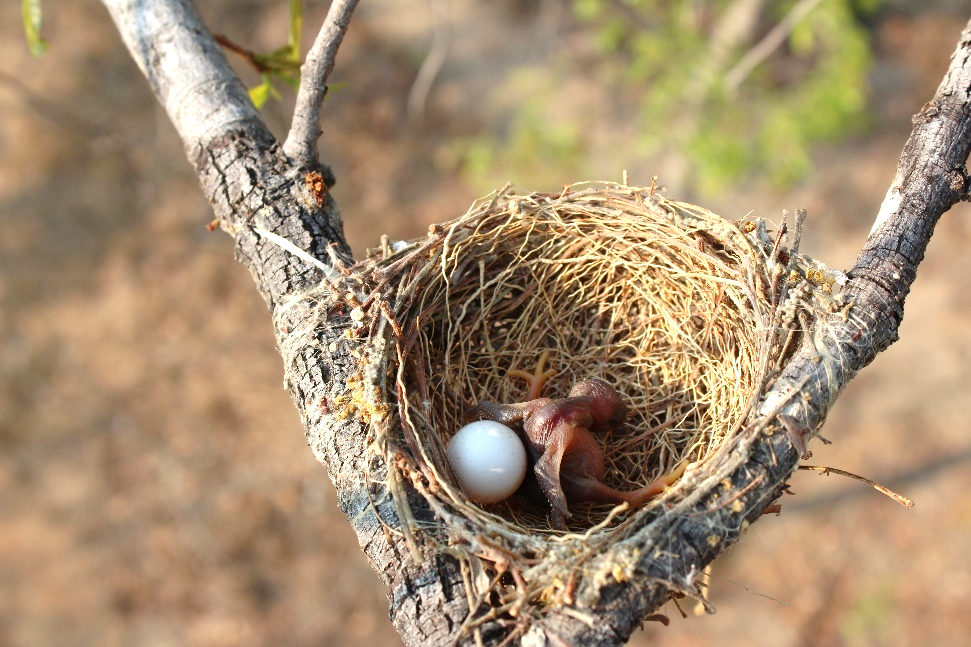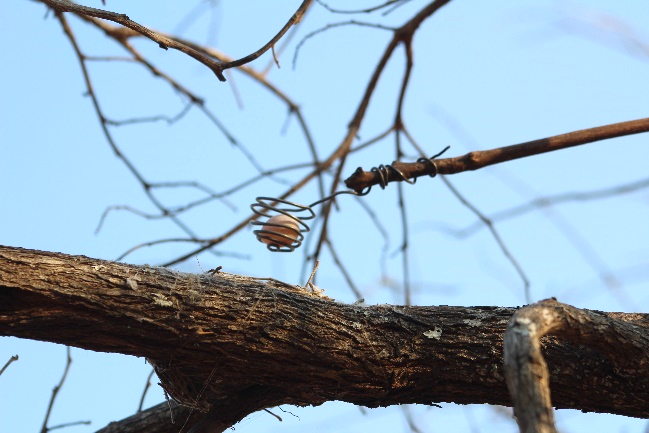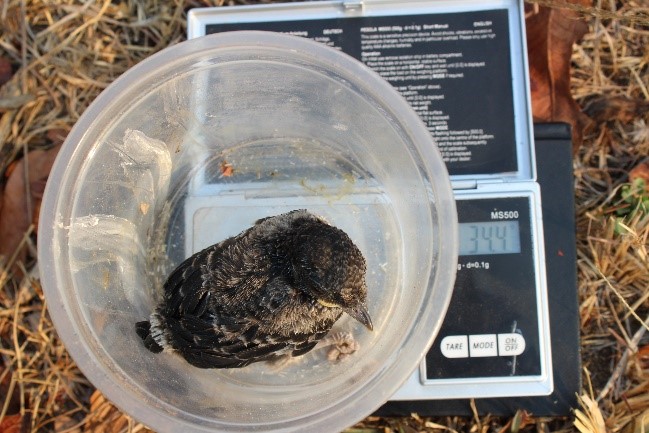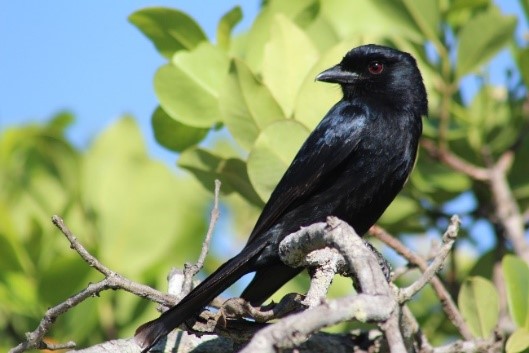By Mairenn Attwood, PhD student in the department of Zoology.

It’s an hour after sunrise, and an African cuckoo chick has just hatched. But it hasn’t hatched in an African cuckoo nest: instead of building their own nests, cuckoo parents lay their eggs in the nests of other birds. This chick has hatched in the nest of a fork-tailed drongo, and is sharing the space with a couple of fork-tailed drongo eggs.
Newly-hatched, the cuckoo chick has no feathers yet, and is still blind. That doesn’t stop its instinctive behaviour, and it sets about manoeuvring the drongo eggs in the nest – balancing one on its back, and pushing it up to the edge of the nest. I can see its feet braced against the twigs as it struggles to lift the weight of the egg. And then it succeeds, and the drongo egg topples over the edge, dropping four metres to the ground, and smashing.

It’s a murderous start to the day. It’s also just one act in an evolutionary battle between African cuckoos and fork-tailed drongos that has played out over thousands of years. My PhD research investigates this battle, and the adaptations both sides have evolved in defence or counter-attack.
To do this, I work with an incredible team of field assistants and nest-finders to locate drongo nests across a 55km2 study site in southern Zambia. Fork-tailed drongos build their nests between September and December, in Zambia’s dry season, creating little cups of twigs which they like to put far out on the end of small branches. After finding a nest, we use a homemade ‘eggspoon’ – a piece of wire coiled onto a stick – to scoop eggs out of the nest one at a time and put them in a box lined with cotton wool.


Once we’ve lowered the cotton wool box, there are a few things to check. First, is there a cuckoo egg among them? Identifying cuckoo egg is a game of spot the difference. Drongo eggs have a range of different markings – from plain white, to small black speckles, to large reddish-brown blotches. If there’s one speckled egg in a nest of otherwise blotchy eggs, that’s a dead giveaway that it’s a cuckoo. But African cuckoo eggs mimic drongo eggs really well, and sometimes it’s difficult to tell if an ever-so-slightly different egg is a cuckoo – or just an oddly-shaped drongo.
After checking for cuckoo eggs, I use a headtorch to light up the eggs from below. This makes it possible to see how long the egg has been incubated for – fresh eggs are clear, then after a few days a small yellow yolk appears. Gradually, a growing embryo with more and more blood vessels becomes visible. Knowing the egg development stage helps with monitoring nests, and for planning experiments.

For experiments, I’m mainly interested in the behaviour of drongos and cuckoos. Drongos are incredible mimics of different sounds, and often mimic other birds’ calls around their nests. Sometimes they mimic alarm calls of other birds, and sometimes they mimic the calls of hawks or cuckoos. Part of my research is trying to work out if this mimicry works to defend drongos against cuckoos and predators. For that, I use speakers to play back drongo alarm calls and mimicry at fake nests, to see how other birds respond. I also use audiomoths (small sound recorders) to record at drongo nests continuously for days. I check these nests regularly, to see if the nest contents get eaten by predators or if a cuckoo lays an egg. This means I can then analyse if nests where drongos use mimicry survive better.

I’m also investigating some of the other, more bizarre, behaviours drongos show. Drongos will happily feed a cuckoo chick in their nest – but then attack it as soon as it flies. When the cuckoo chick lands nearby, the drongos start feeding it again. I’m trying to work out why drongos show such a dramatic switch in behaviour, using 3D-printed models of cuckoo and drongo chicks. I’m using a remote-control release mechanism to fly those model birds down a zipline, testing how drongos respond to cuckoo chicks as they leave the nest.
I’m also working with other researchers to find out how these birds cope with extreme heat. Increasingly frequent heatwaves and droughts are occuring across Southern Africa, and many bird species struggle to keep their chicks cool enough and well-fed. In the dry season in Zambia, where temperatures regularly soar above 35 degrees, I’m monitoring how well drongos manage. This means weighing and measuring drongo chicks from different nests, to see if their growth is affected by temperature.

Alongside the research itself, the field season invovles outreach and keeping the fleet of trusty vehicles in good condition – sometimes I think I learn as much about car mechanics as about birds! All of the research is made possible by the wider African cuckoo team, led by senior field workers Collins Moya and Silky Hamama, and as team we share our enthusiasm for the birds wherever we can. A recent David Attenborough documentary included a scene filmed at the field site, so we strung up a bedsheet over the goalposts on the football pitch, and projected the documentary on there; and we also work in Popota primary school to share the findings.

Want to know more? You can find details of various projects on our research group website https://www.africancuckoos.com/ , read one of our recent papers on drongos and cuckoos here: https://doi.org/10.1098/rspb.2022.1506 , or see a news article summary some of our research here: https://www.theguardian.com/science/2023/jul/26/spot-the-difference-why-drongos-are-likely-to-clock-african-cuckoo-eggs-94-of-the-time .


